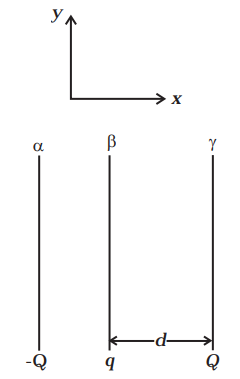Two fixed, identical conducting plates (α & β ) , each of surface area S are charged to –Q and q, respectively, where
Q > q > 0. A third identical plate (γ ), free to move is located on the other side of the plate with charge q at a distance d (Fig ). The third plate is released and collides with the plate β . Assume the collision is elastic and the time of collision is sufficient to redistribute charge amongst β & γ .

(i) Find the electric field acting on the plate γ before collision.
(ii) Find the charges on β and γ after the collision.
(iii) Find the velocity of the plate γ after the collision and at a distance d from the plate β.